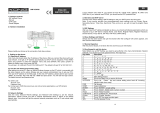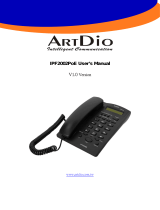Page is loading ...

User’s Manual
IP Telephony Gateway
Model No.: SP5001C, SP5001D, SP5002A, SP5012A
Website: http://www.micronet.info

1
About this User’s Manual
This User’s Manual gives users basic steps on installation and operation.
Please read this manual chapter by chapter.
Chapter 1. Introduction
Introduce the IP Telephony Gateway to users in terms of feature,
appearance, and application.
Chapter 2. Startup
Help user complete basic configuration.
Chapter 3. Operation
Show user how to use the device to process phone call and FAX.
Chapter 4. Web Administration
Provide command reference of Web Interface for advanced setting.
Chapter 5. IVR/Keypad Management
Provide instructions on configuring the IP Telephony gateway via Keypad
on the phone set.
Chapter 6. Specification
List the specification of the gateway in detail.
Online Upgrade
Please refer to http://www.micronet.info/ for additional support.

2
Table of Content
1...Introduction.............................................................................................. 4
1.1 Key Features ................................................................................................ 5
1.2 Physical Description ..................................................................................... 6
1.3 Application.................................................................................................. 10
2...Startup .................................................................................................... 13
2.1 Login into the System................................................................................. 13
2.2 Network Configuration................................................................................ 15
2.3 SIP Configuration ....................................................................................... 17
2.4 VPN Configuration...................................................................................... 19
2.5 DDNS ......................................................................................................... 21
3...Operation................................................................................................ 22
3.1 Make a Call ................................................................................................ 22
3.1.1 Make PSTN Call (SP5001D only) ................................................................. 22
3.2 Speed Dial / P2P call.................................................................................. 23
3.3 Call Forward ............................................................................................... 24
3.4 Call Hold / Call Waiting / Conference ......................................................... 25
3.5 FAX............................................................................................................. 26
4...Web Administration............................................................................... 27
4.1 Phone Book................................................................................................ 27
4.2 Phone Setting............................................................................................. 27
4.2.1 Call Forward .................................................................................................. 27
4.2.2 SNTP Settings............................................................................................... 27
4.2.3 Volume Settings ............................................................................................ 27
4.2.4 Block Settings................................................................................................ 28
4.2.5 Caller ID ........................................................................................................ 28
4.2.6 Dial Plan Setting............................................................................................ 28
4.2.7 Flash Time Setting......................................................................................... 30
4.2.8 Call Waiting Setting ....................................................................................... 30
4.2.9 T.38 (FAX) Setting ......................................................................................... 31
4.3 Network ...................................................................................................... 32
4.3.1 Status............................................................................................................. 32
4.3.2 WAN Settings ................................................................................................ 32
4.3.3 LAN Settings ................................................................................................. 32
4.3.4 DDNS Settings .............................................................................................. 33
4.3.5 VLAN Settings ............................................................................................... 33
4.3.6 PPTP Settings ............................................................................................... 34

3
4.3.7
DMZ * ............................................................................................................ 34
4.3.8 Virtual Server * .............................................................................................. 34
4.4 SIP Settings................................................................................................ 35
4.4.1 Service Domain ............................................................................................. 35
4.4.2 Port Settings.................................................................................................. 35
4.4.3 Codec Settings .............................................................................................. 35
4.4.4 Codec ID Settings ......................................................................................... 36
4.4.5 DTMF Setting ................................................................................................ 36
4.4.6 RPort Setting ................................................................................................. 36
4.4.7 Other Settings ............................................................................................... 37
4.5 NAT Trans. / STUN..................................................................................... 38
4.6 Others......................................................................................................... 39
4.6.1 Auto Config.................................................................................................... 39
4.6.2 ICMP Setting ................................................................................................. 39
4.6.3 PTT Setting ................................................................................................... 39
4.7 System Auth. .............................................................................................. 40
4.8 Save Change.............................................................................................. 40
4.9 Update........................................................................................................ 40
4.9.1 New Firmware ............................................................................................... 40
4.9.2 Default Setting............................................................................................... 41
4.10 Reboot........................................................................................................ 41
5...IVR / Keypad Management.................................................................... 42
6...Specification........................................................................................... 44

4
1. Introduction
Micronet SP5001C, SP5001D, SP5002A and SP5012A IP Telephony
Gateway is designed to connect standard telephone devices to IP-based
telephony networks, providing users with high-quality VoIP service.
SP5001C / SP5002A provides:
● 1/2 FXS port(s) for phone set, FAX machine, or PBX’s trunk
SP5001D provides:
● 1 FXS port for phone set, FAX machine, or PBX’s trunk
● 1 PSTN port for PSTN lifeline that tranceives PSTN calls as backup
even if VoIP fails.
SP5012A provides:
● 1 FXS port for phone set, FAX machine, or PBX’s trunk
● 1 FXO port for PSTN line or PBX’s extension to make communication
between PSTN and IP clients.
With built-in router function, they offer internet access sharing to co-located
PCs. The simple operation and configuration features are the most suitable
for residential and SOHO applications.

5
1.1 Key Features
z Compliant with IETF SIP standards
z Provide 2 10/100M RJ-45 ports for WAN and LAN connection
z Support G.729a/b, G.711a/µ-law, and G.726 codecs
z Support up to 3 SIP service domains
z Support STUN and Outbound proxy for NAT traversal
z Support VAD, CNG, EC, and Adaptive Jitter Buffer
z Support FSK / DTMF caller ID display
z Support Call Hold / Call Waiting / Call Forward
z Support 3-way conference
z Provide phone address book and speed dialing function
z Transmit voice and FAX (T.38 and in-band)
z Support PPTP client for VPN
z Support IP ToS/DSCP, and 802.1q/p for QoS
z Easy management via WEB and IVR/keypad

6
1.2 Physical Description
SP5001C:
SP5001C Front Panel
LED Status Description
PWR On/Green Power On
STATUS On/Amber Line Registered
TEL On/Amber Phone set off-hook
LAN On/Green Link On
WAN On/Green Link On
SP5001C Rear Panel
---------------------------------------------------------------------------------------------------
RESET Factory default button. Press and hold for 5 seconds to reset
WAN RJ-45 port of 10/100M for connecting to modem
LAN RJ-45 port of 10/100M for connecting to PC or hub/switch that
connects PCs
TEL RJ-11 port for connecting to phone set or PBX trunk
---------------------------------------------------------------------------------------------------

7
SP5001D:
SP5001D Front Panel
LED Status Description
PWR On/Green Power On
PSTN On/Amber PSTN mode / VoIP Unregistered
TEL On/Amber Phone set off-hook
LAN On/Green Link On
WAN On/Green Link On
SP5001D Rear Panel
---------------------------------------------------------------------------------------------------
RESET Factory default button. Press and hold for 5 seconds to reset
WAN RJ-45 port of 10/100M for connecting to modem
LAN RJ-45 port of 10/100M for connecting to PC or hub/switch that
connects PCs
TEL RJ-11 port for connecting to phone set or PBX trunk
PSTN RJ-11 port for connecting to PSTN (lifeline)
---------------------------------------------------------------------------------------------------

8
SP5002A:
SP5002A Front Panel
LED Status Description
PWR On/Green Power On
TEL1 On/Amber Line Registered
TEL2 On/Amber Line Registered
LAN On/Green Link On
WAN On/Green Link On
SP5002A Rear Panel
---------------------------------------------------------------------------------------------------
RESET Factory default button. Press and hold for 5 seconds to reset
WAN RJ-45 port of 10/100M for connecting to modem
LAN RJ-45 port of 10/100M for connecting to PC or hub/switch that
connects PCs
TEL1 RJ-11 port for connecting to phone set or PBX trunk
TEL2 RJ-11 port for connecting to phone set or PBX trunk
---------------------------------------------------------------------------------------------------

9
SP5012A:
SP5012A Front Panel
LED Status Description
PWR On/Green Power On
TEL On/Amber Line Registered
LINE On/Amber Line Registered
LAN On/Green Link On
WAN On/Green Link On
SP5012A Rear Panel
---------------------------------------------------------------------------------------------------
RESET Factory default button. Press and hold for 5 seconds to reset
WAN RJ-45 port of 10/100M for connecting to modem
LAN RJ-45 port of 10/100M for connecting to PC or hub/switch that
connects PCs
LINE RJ-11 port for connecting to PSTN or PBX extension
TEL RJ-11 port for connecting to phone set or PBX trunk
---------------------------------------------------------------------------------------------------

10
1.3 Application
SP5001C:
● 1 RJ-11 FXS port is provided for phone set or PBX's trunk line
connection
● 2 RJ-45 ports of 10/100M are provided for WAN and LAN connection
● The IP telephony gateway can share Internet access with LAN clients
SP5002A:
● 2 RJ-11 FXS ports are provided for phone set or PBX's trunk line
connection
● 2 RJ-45 ports of 10/100M are provided for WAN and LAN connection
● The IP telephony gateway can share Internet access with LAN clients

11
SP5001D:
● 1 RJ-11 FXS port is provided for phone set or PBX's trunk line
connection
● 1 RJ-11 PSTN port is provided to tranceive PSTN calls as backup even
if VoIP fails
● 2 RJ-45 ports of 10/100M are provided for WAN and LAN connection
● The IP telephony gateway can share Internet access with LAN clients
SP5012A:
● 1 RJ-11 FXS port is provided for phone set or PBX's trunk line
connection
● 1 RJ-11 FXO port is provided for PSTN or PBX's extension connection,
and for PSTN client to communicate with IP client
● 2 RJ-45 ports of 10/100M are provided for WAN and LAN connection
● The IP telephony gateway can share Internet access with LAN clients

12
VPN (Virtual Private Network)
The IP telephony gateway series supports PPTP client for VPN function. It
can establish VPN tunnel with PPTP server, and get access to the peer
private network as if it is located in the same LAN.
For special condition that SIP proxy server is located in the private network of
CO site, the gateway can register, and request a phone call via the VPN
tunnel.
Please refer to the section 2.4 VPN Settings.

13
2. Startup
2.1 Login into the System
The embedded web configuration allows you to use a web browser to
manage the IP Telephony gateway.
Step 1. Connect LAN port to your managing PC. Or, connect the gateway
with PC by hub/switch.
Step 2. Launch your web browser with http://192.168.123.1:9999/. Please
configure IP address of PC with 192.168.123.x.
Step 3. The Password screen now appears. Type “root” in the user name
field and your password (none by default) in the password field.
Step 4. Click on Login.
Login Screen
Step 5. After a successful login, you will see the screen System Information
as shown below.

14

15
2.2 Network Configuration
By default, the gateway is in NAT mode (router mode) and can share Internet
access with PCs. Go to [ Network / WAN Settings ], and configure WAN
setting according to actual condition. In default IP type of DHCP client, it
requests necessary IP information from your ISP automatically.
-----------------------------------------------------------------------------------------------------
Note: Different ISPs require different methods of connecting to the Internet. Please
consult your ISP to select right IP type (Fixed IP, PPPoE) of WAN.
-----------------------------------------------------------------------------------------------------

16
-----------------------------------------------------------------------------------------------------
Parameter Description
-----------------------------------------------------------------------------------------------------
LAN Mode Bridge: pure VoIP gateway
NAT: VoIP router
IP Type Select Fixed IP, DHCP (default), or PPPoE
IP IP address provided by ISP
Mask Subnet mask provided by ISP
Gateway ISP’s IP address gateway
DNS Server1/2 IP address of primary/secondary DNS server
MAC MAC address
PPPoE
Username User Name provided by ISP for the PPPoE connection
Password Password provided by your ISP for the PPPoE connection
-----------------------------------------------------------------------------------------------------
When Router mode is disabled, the unit is just a pure VoIP gateway. In LAN
mode, select Bridge to disable router mode.
-----------------------------------------------------------------------------------------------------
Note:
1. Please save and reboot the system to take effect. Go to [ Save Change ] to save
configuration, and the system will reboot automatically.
2. Please unplug LAN port when LAN mode is Bridge. Just keep WAN port plugged.
----------------------------------------------------------------------------------------------------

17
2.3 SIP Configuration
Go to [ SIP Settings / Service Domain ]. Each port can be configured to
register 3 different service domains.
-----------------------------------------------------------------------------------------------------
Parameter Description
-----------------------------------------------------------------------------------------------------
Phone No. Select specific port to configure
Active Select “On” to activate
User Name IP telephony number of the line
Register Name User’s ID
Register Password Password
Domain Server Domain server IP
Proxy Server SIP proxy IP and Port (default: 5060)
<sip_proxy_ip>:<sip_proxy_port>
Outbound Proxy Outbound proxy IP and Port
<outbound_proxy_ip>:< outbound_proxy_port>
Status Registered or not.
-----------------------------------------------------------------------------------------------------
Go to [ NAT Trans. / STUN Setting ] to set up STUN On, if necessary.

18
-----------------------------------------------------------------------------------------------------
Note: Please save and reboot the system to take effect. Go to [ Save Change ] to save
configuration, and the system will reboot automatically.
-----------------------------------------------------------------------------------------------------

19
2.4 VPN Configuration
IP telephony gateway supports PPTP client for VPN. It can establish VPN
tunnel with PPTP server. Go to [ Network / PPTP Settings ], and set PPTP
server address, and authentication information (username, password).
-----------------------------------------------------------------------------------------------------
Parameter Description
-----------------------------------------------------------------------------------------------------
PPTP Server Set IP address of PPTP server
PPTP Username Set username for authentication to set up VPN tunnel
PPTP Password Set password for authentication to set up VPN tunnel
-----------------------------------------------------------------------------------------------------
Click on Submit, and save to take effect.
/


